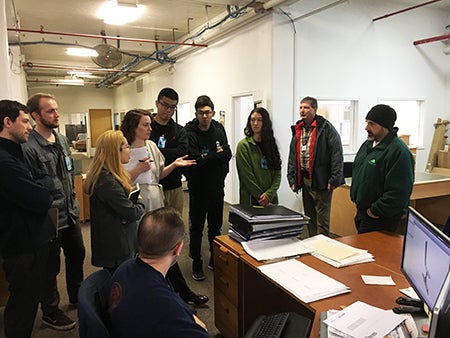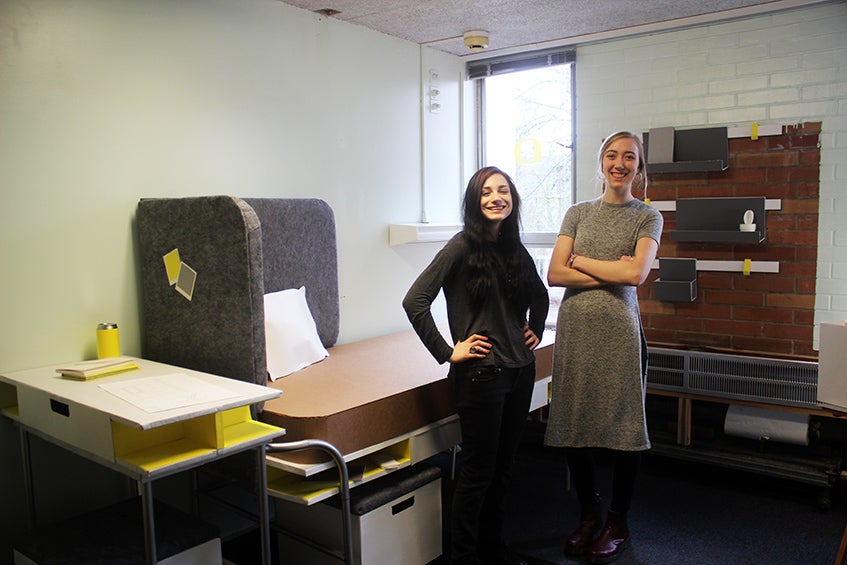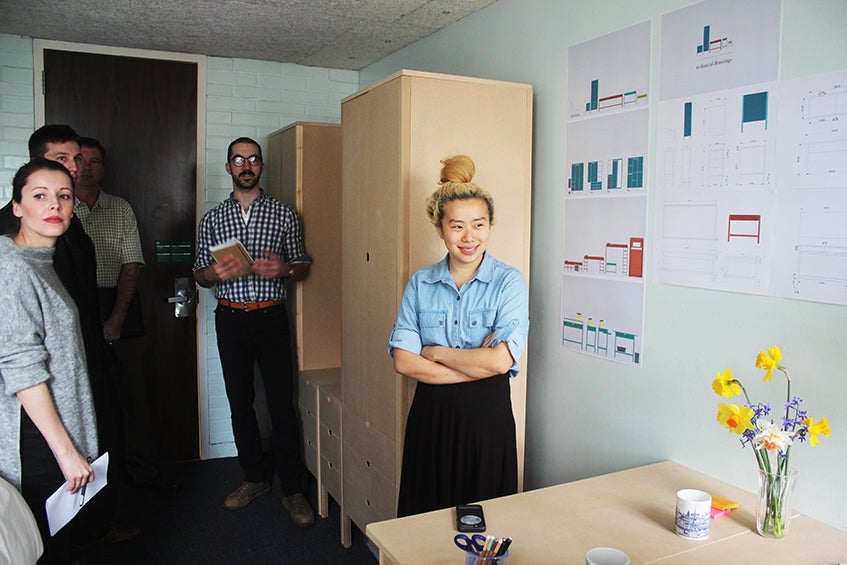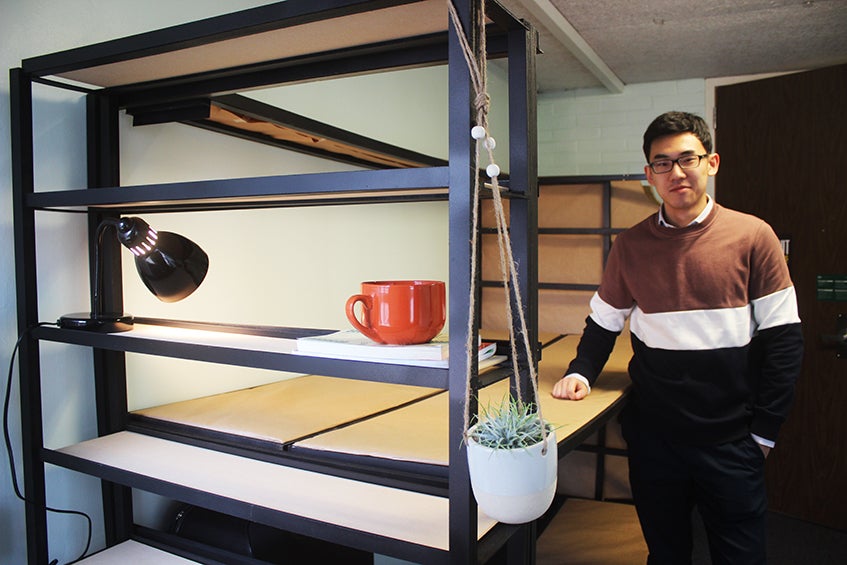What would inspire 15 University of Oregon seniors to stay the night in the freshman residence at Bean Hall?
Ultimately, to help 600 freshmen each year have a better living experience. But to get there, the seniors — in the Product Design 484 “Compact Living” studio — spent a night in the residence hall to generate ideas for the state prison system, whose inmates have built UO residence hall furniture for two decades.

Above: UO product design students visit the Oregon Correctional Enterprises’ furniture factory where inmates make a variety of furnishings. Photo courtesy OCE.
The students used their sleepover to help design and fabricate prototype furnishings over winter term 2017, including beds, desks, wardrobes, storage drawers, and chairs for the more than 300 rooms in Bean Hall, which is being renovated.
Most product design studio courses devote an entire term to detailing just one type of item, but this studio considered an entire room of furnishings and their different potential users. Redesigning multiple furnishings to exact dimensions and lighting qualities could take a professional a year to resolve — but the students had just 10 weeks.
The experience was part of a “48-hour observational study” the first week of winter term. For some, it was a nostalgic experience that stirred memories of living in intimate quarters, which in this case ranges from 136 to 147 square feet.
“I forgot what it was like to sleep across from someone, go to the bathroom and see other people,” said design student Isabel McDowall. “It’s a very personal relationship.”
Conversations with current Bean residents and UO Housing staff also gave the designers insight into residence hall woes.
“One complaint was that shorter students [have to] run and jump onto the bed,” student Lydia Bales said. “The sleepover gave us an opportunity to interact with furniture and expose different ways to solve problems. Like: when you take a shower, what do you do with the towel?”
McDowall observed: “People study in their beds so much. Pretty much everyone we talked to said they don’t need a desk. So in our design, the desk is de-emphasized.”
Natalie Thomas and Alex Caves created hypothetical freshmen personas and designed the room’s layout to suit their needs: Danny, an athlete, has his furnishings low to the ground, so he can reach everything from his bed and won’t strain his broken leg. Sandy and Sarah, two best friends, share everything and need space for crafting.
“It is a real challenge. They need to design a successful solution that can work in multiple arrangements and answer all the functional needs of the occupants,” said Associate Professor John Arndt, who co-taught the studio with Instructor Tom Bonamici.
“To research, design, and build a full room’s set of furniture in 10 weeks is a tall order,” product design major Sarah Hashiguchi noted. “The pieces chosen from this studio will be manufactured for 600 people, and hopefully be around for decades to come — that is a lot of pressure to perform at our best.”

Above: The students meet at Oregon Correctional Enterprises. Photo courtesy OCE.
For this studio, the UO partnered with the Oregon Corrections Enterprises (OCE), an agency that offers work and training programs to adults in custody with the Oregon Department of Corrections (DOC). While OCE looks for innovative updates to their product lines, they also seek ways to educate the public about the connection between DOC’s and OCE’s mission and the resulting societal benefits of reduced recidivism.
The students visited OCE’s wood and metal manufacturing facility, where approximately 115 inmates train as carpenters and machine operators, among other positions.
“You see why the spots are so coveted. The shops give the [inmates] a sense of purpose and a productive routine in their day,” said student Amanda Kibbel. “I am impressed with how many pieces of furniture they manufacture in such a short amount of time.”
Near the end of the term, students presented their final designs to reviewers including OCE employees.
“Each of the seven student teams did a great job on this project, with unique and fresh new looks,” said Michael Kezeor, OCE new business development manager.
The instructors “encouraged us to push ourselves beyond what’s currently being produced and reimagine how students can best use the space,” design student Cara Murray said. “It has also been an amazing opportunity to design something with the potential to have wide-reaching influence on campus.”
OCE’s design team and fabricators will soon select the student designs deemed most practical, durable, and replicable for Bean Hall. Ultimately, the choice to purchase the furnishings belongs to University Housing. If OCE is the chosen vendor, the adults in custody will fabricate the furnishings this summer.
“The social element of this partnership is a wonderful reflection on the program,” said Kiersten Muenchinger, director of the Department of Product Design. “We’re working with students to help train adults in custody to help them live healthy, productive lives.”

Above: Sara Murillo (left) and Cara Murray in their room in Bean Hall during the final review for their Product Design 484 studio. Photo by Emerson Malone.

“We wanted to create a place where someone could come back at the end of the day and feel safe and cozy,” said Amanda Kibbel, pictured above, right side. Above left, Zoë Mowat, Stott Visiting Professor in Interior Architecture. Photo by Emerson Malone.

Above: Zihan Wang beside the bunk bed in his group’s Bean Hall room design. Photo by Emerson Malone.

Above: Max Friday (left) and Lydia Bales show their room design. Photo by Emerson Malone.
